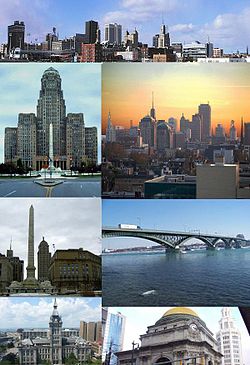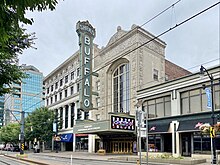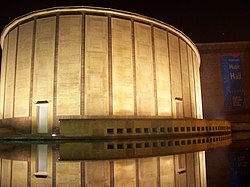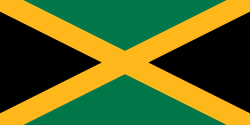Buffalo
| Buffalo | |
|---|---|
 | |
| Poloha | |
| Souřadnice | 42°53′11″ s. š., 78°52′41″ z. d. |
| Nadmořská výška | 183 m n. m. |
| Časové pásmo | Eastern Time Zone |
| Stát | |
| Federální stát | New York |
| Okres | Erie County |
(c) NordNordWest, CC BY 3.0 Buffalo | |
| Rozloha a obyvatelstvo | |
| Rozloha | 136,0 km² |
| Počet obyvatel | 278 349 (2020)[1] |
| Hustota zalidnění | 2 047,3 obyv./km² |
| Správa | |
| Starosta | Christopher Scanlon (od 2024) |
| Vznik | 1832 |
| Oficiální web | www |
| Telefonní předvolba | 716 |
| PSČ | 14201–14280, 14201, 14204, 14208, 14211, 14213, 14215, 14218, 14216, 14221, 14224, 14227, 14231, 14235, 14238, 14240, 14242, 14243, 14244, 14246, 14248, 14250, 14255, 14257, 14260, 14262, 14264, 14265, 14268, 14270, 14272, 14275, 14276 a 14278 |
| Některá data mohou pocházet z datové položky. | |
Buffalo ([výslovnost]: ˈbʌfəloʊ) je město ležící na západě státu New York ve Spojených státech amerických. Má 255 244 obyvatel (podle sčítání z roku 2020) a je tak druhým nejlidnatějším městem státu New York. Město leží na východním břehu Erijského jezera jižně od odtoku řeky Niagara. Niagarské vodopády jsou vzdálené přibližně 27 kilometrů severně od centra a kanadské největší město Toronto leží 95 km severozápadně od Buffala. Buffalo je sídelním městem kraje Erie County a centrem oblasti Buffalo-Niagara Falls metropolitan area.
Původ jména Buffalo je nejasný, ačkoliv podle nejznámější domněnky jde o zkomoleninu francouzského výrazu beau fleuve, neboli "krásná řeka". Tato domněnka je však lehce vyvratitelná při pohledu do literatury – francouzští průzkumníci totiž řeku Niagara označovali jako Rivière aux Chevaux, tedy "Koňská řeka". Další možností je, že název vznikl jako vzpomínka na místo, které se objevuje v příběhu o ukradeném koňském mase, které se vydávalo za bizoní. Ani tato pověst ovšem není doložena. Faktem ovšem zůstává, že se bizoni (anglicky buffalo) v oblasti nikdy nevyskytovali a že jméno Buffalo je odvozeno od nedalekého toku Buffalo Creek, který byl poprvé zaznamenán na mapě z let 1759–1760.
Dějiny
Oblast byla původně osídlena původními obyvateli z tzv. neutrálního národa a později dobyta kmenem Seneků. Roku 1804 navrhl Joseph Ellicott, hlavní jednatel firmy Holland Land Company, pro město – jako jedno z mála v Americe – radiální síť ulic, rozpínající se od středu města. Během války v roce 1812 bylo město spáleno britskými jednotkami. 4. listopadu 1825 byl vybudován Erijský kanál a Buffalo se tak ocitlo na strategickém místě. Díky kanálu rostl význam oblasti, rozvíjel se obchod a rostl také počet obyvatelstva – roku 1832 se Buffalo s 10 tisíci obyvateli oficiálně stalo městem.
Během 40. let 19. století se přístav v Buffalu dále rozvíjel a roku 1843 zde byl zkonstruován první parou poháněný výtah na obilí, který urychloval překládku obilí z lodí z jezera na kanál a později na železnici. Při své inaugurační cestě se v Buffalu 16. února 1861 zastavil Abraham Lincoln. Během občanské války obyvatelstva v Buffalu neustále přibývalo, až roku 1865 dosáhlo město 94 210 obyvatel. Žila zde také početná afroamerická komunita, která se podílela na abolicionistickém hnutí. Město bylo na straně Unie a kromě vojáků přispívalo také výrobou válečného materiálu.
Na konci 19. století si město vysloužilo přezdívku město světel, neboť bylo prvním americkým městem s veřejným osvětlením (1881). Elektrická energie se vyráběla z vodní energie z řeky Niagara. Dále zde vzkvétal automobilový průmysl a v roce 1901 se v Buffalu konala panamerická výstava.
20. léta 20. století byla obdobím urbanistického rozmachu – roku 1927 byl postaven most Peace Bridge, spojující Buffalo s kanadským Fort Erie, ležícím na druhém břehu jezera, a o dva roky později bylo dokončeno hlavní nádraží Buffalo Central Terminal.
Druhá světová válka znamenala pro město období prosperity, a to díky jeho průmyslovému charakteru. Avšak s otevřením průplavu Svatého Vavřince v roce 1957 se ekonomika města zhoršila a nastalo období deindustrializace. Ekonomická situace se pochopitelně odrazila i v úbytku obyvatelstva. Začátek 21. století ale pro město vypadá příznivě – turistický ruch je podporován výstavbou nových hotelů a za zmínku stojí i rozvoj centra, především kulturní akce v okolí Elmwood Avenue.
Podnebí
Buffalo má poměrně vlhké kontinentální klima, které je ovšem značně ovlivněné klimatem Velkých jezer. Zimy jsou obvykle dlouhé, obvykle od poloviny listopadu do poloviny března, se sněhovou pokrývkou od prosince do začátku března. Město zažilo několik velkých sněhových bouří, nejznámější jsou z roku 1977 a z října 2006. Na druhou stranu má město nejslunečnější a nejsušší léta na severovýchodě Spojených států. Jezero Erie ovlivňuje letní počasí tak, že tvoří lehký vánek, díky kterému teplota nikdy nevystoupí nad 37 °C.
Demografie
Podle sčítání lidu z roku 2010 zde žilo 261 310 obyvatel.[2]
Rasové složení
- 50,4% Bílí Američané
- 38,6% Afroameričané
- 0,8% Američtí indiáni
- 3,2% Asijští Američané
- 0,0% Pacifičtí ostrované
- 3,9% Jiná rasa
- 3,1% Dvě nebo více ras
Obyvatelé hispánského nebo latinskoamerického původu, bez ohledu na rasu, tvořili 10,5% populace.[2]
Sport
V Buffalu má sídlo hokejový tým NHL Buffalo Sabres.
Je zde také tým amerického fotbalu Buffalo Bills, který hraje ve městě Orchard Park.
V letech 2011 a 2018 se zde konalo Mistrovství světa juniorů v ledním hokeji.
Kultura a hudba
Buffalo Philharmonic Orchestra
Buffalo Philharmonic Orchestra je americký symfonický orchestr se sídlem v Buffalu. Jeho hlavním působištěm je Kleinhans Music Hall, jejíž akustika je ceněna a která je národní historickou památkou.[3]
Orchestr založili Cameron Baird, Frederick Slee a Samuel P. Capen v roce 1934. V roce 1998 se hudební ředitelkou Buffalo Philharmonic Orchestra stala JoAnn Falletta.[4] Mezi předchozí hudební ředitele Buffalské filharmonie patřili William Steinberg, Josef Krips, Lukas Foss, Michael Tilson Thomas, Semyon Bychkov och Maximiano Valdés. Dalšími slavnými dirigenty, kteří orchestr řídili, byli Leonard Bernstein, Igor Stravinsky, Ralph Vaughan Williams, Sir Neville Marriner a Henry Mancini. Pod vedením JoAnn Falletty získal orchestr v roce 2009 nominace na cenu Grammy a několik ocenění Grammyy za "Nejlepší skladbu moderní vážné hudby".[5] Mezi sólisty, kteří s BPO vystupovali, patří Van Cliburn, Renée Fleming, André Watts, Beverly Sills, Plácido Domingo, Yo-Yo Ma, Anne-Sophie Mutter, Joshua Bell, a Midori.
Nickel City Opera

Nickel City Opera (známá také jako NC Opera Buffalo nebo NCO) je americká opera v Buffalu. Nickel City Opera je dnes jednou z předních oper v USA a se svým sídlem a hlavní scénou v Shea's Performing Arts Center s více než 3 000 místy je jedním z největších operních domů na světě.[6][7] NCO založil v roce 2004 Valerian Ruminski. Od té doby si Nickel City Opera nejen objednává nové opery, ale uvádí i světové premiéry významných děl. NCO spolupracuje s filharmonickým orchestrem Buffalo Philharmonic Orchestra[8]a společně uvádí širokou škálu děl od baroka 18. století a belcanta 19. století přes minimalismus 20. století až po moderní opery 20. a 21. století. Tyto opery jsou uváděny v inscenacích, jejichž styl se pohybuje od propracované tradiční výpravy až po moderní koncepční design. V letech 2017–2021 byl pak hudebním ředitelem a šéfdirigentem Němec Matthias Manasi.[9]
NCO sídlí v Shea's Performing Arts Center (3 019 míst) v divadelní čtvrti Buffalo Theatre District v centru Buffala.[10] Shea's Performing Arts Center navrhla známá chicagská firma "Rapp and Rapp".[11] Opera byla navržena ve stylu evropských operních domů a pyšní se dekoracemi kombinujícími francouzské a španělské baroko a rokoko.[12] Interiér navrhl světoznámý designér a umělec Louis Comfort Tiffany a většina prvků se zachovala dodnes.[13] Původně zde bylo téměř 4 000 míst, ale ve 30. letech minulého století byl počet míst snížen na současných 3 019.[14] Důvodem bylo v neposlední řadě zvětšení prostoru pro orchestr díky zvětšení orchestřiště.
Slavní rodáci
- Herman Hollerith (1860–1929), americký statistik, matematik a informatik a vynálezce
- Frances Clevelandová (1864–1947), manželka 22. prezidenta USA Grovera Clevelanda, první dáma USA v letech 1886–1889 a 1893–1897
- Jeffrey DeMunn (* 1947), americký herec
- Christine Baranski (* 1952), americká herečka
- John G. Roberts (* 1955), americký právník, od roku 2005 úřadující předseda Nejvyššího soudu USA
- Lex Luger (* 1958), americký bývalý profesionální wrestler
- Kyle Chandler (* 1965), americký herec
- David Boreanaz (* 1969), americký herec
- Chad Michael Murray (* 1981), americký herec
- Nick Foligno (* 1987), americký hokejový útočník
- Patrick Kane (* 1988), americký hokejový útočník, trojnásobný držitel Stanley Cupu
- Jessica Pegulaová (* 1994), americká profesionální tenistka
Fotogalerie
Partnerská města
 Abuja, Nigérie (2004)
Abuja, Nigérie (2004) Baní, Dominikánská republika (2011)
Baní, Dominikánská republika (2011) Bursa, Turecko (2010)
Bursa, Turecko (2010) Cape Coast, Ghana (1976)
Cape Coast, Ghana (1976) Čchang-čou, Čína
Čchang-čou, Čína Dortmund, Německo (1972)
Dortmund, Německo (1972) Drohobyč, Ukrajina (2000)
Drohobyč, Ukrajina (2000) Horlivka, Ukrajina (2007)
Horlivka, Ukrajina (2007) Jongčchon, Jižní Korea (2011)
Jongčchon, Jižní Korea (2011) Kanazawa, Japonsko (1962)
Kanazawa, Japonsko (1962) Kirjat Gat, Izrael (1977)
Kirjat Gat, Izrael (1977) Lille, Francie (2000)
Lille, Francie (2000) Muhanga District, Rwanda (2011)
Muhanga District, Rwanda (2011) Řešov, Polsko (1975)
Řešov, Polsko (1975) Saint Ann's Bay, Jamajka (2007)
Saint Ann's Bay, Jamajka (2007) Siena, Itálie (1961)
Siena, Itálie (1961) Torremaggiore, Itálie (2004)
Torremaggiore, Itálie (2004) Tver, Rusko (1989)
Tver, Rusko (1989)
Odkazy
Reference
- ↑ 2020 United States Census. Dostupné online. [cit. 2022-01-01].
- ↑ a b United States Census Bureau, sčítání z roku 2010 [online]. American FactFinder. Dostupné online.
- ↑ ROTHSTEIN, Edward. If Music Is the Architect. nytimes.com [online]. 2004-05-22 [cit. 2022-06-25]. Dostupné online. (anglicky)
- ↑ WOOLFE, Zachary. Buffalo Philharmonic, Once Languishing, Has Come a Long Way. nytimes.com [online]. 2016-10-25 [cit. 2018-03-29]. Dostupné online. (anglicky)
- ↑ ROBERTO, Toni. Buffalo Philharmonic Orchestra earns three Grammy nominations. buffalonews.com [online]. 2020-11-25 [cit. 2023-04-17]. Dostupné online. (anglicky)
- ↑ AM-POL EAGLE. Ruminski receives Opera America award, NCO prepares Roadshow Opera. ampoleagle.com [online]. 2017-05-11 [cit. 2019-11-03]. Dostupné online. (anglicky)
- ↑ ORANGESMILE. Shea's Buffalo Theatre, United States. orangesmile.com [online]. 2024-01-02 [cit. 2024-01-31]. Dostupné online. (anglicky)
- ↑ DAWN, Bracely. Classical: Continued success for BPO, Nickel City Opera. buffalonews.com [online]. 2013-01-04 [cit. 2012-02-17]. Dostupné online. (anglicky)
- ↑ AM-POL EAGLE. Manasi to leave the NCO. ampoleagle.com [online]. 2021-06-18 [cit. 2022-04-16]. Dostupné online. (anglicky)
- ↑ PARLATO, Frank. SHOT! Nickel City Opera Lays Its Future On The Line With Premiere Of New Opera About The History Of Buffalo. artvoice.com [online]. 2016-06-16 [cit. 2022-02-25]. Dostupné online. (anglicky)
- ↑ SCHOBER, Jeff. The majesty of Shea’s Performing Arts Center: what you've never known before. buffalonews.com [online]. 2021-03-16 [cit. 2022-08-14]. Dostupné online. (anglicky)
- ↑ EVERGREENE ARCHITECTURAL ARTS. Shea’s Performing Arts Center. evergreene.com [online]. 2024-01-08 [cit. 2024-02-11]. Dostupné online. (anglicky)
- ↑ SOMMER, Mark. At 90, Shea’s Performing Arts Center is better than ever. buffalonews.com [online]. 2016-01-09 [cit. 2020-03-31]. Dostupné online. (anglicky)
- ↑ EISENBERG, Jana. Buffalo Architectural Spotlight: Shea’s Performing Arts Center. visitbufalloniagara.com [online]. 2018-04-03 [cit. 2023-07-16]. Dostupné online. (anglicky)
Související články
Externí odkazy
 Obrázky, zvuky či videa k tématu Buffalo na Wikimedia Commons
Obrázky, zvuky či videa k tématu Buffalo na Wikimedia Commons  Encyklopedické heslo Buffalo v Ottově slovníku naučném ve Wikizdrojích
Encyklopedické heslo Buffalo v Ottově slovníku naučném ve Wikizdrojích- Oficiální stránky
- University at Buffalo (anglicky)
Média použitá na této stránce
Autor: Uwe Dedering, Licence: CC BY-SA 3.0
Location map of the USA (without Hawaii and Alaska).
EquiDistantConicProjection:
Central parallel:
* N: 37.0° N
Central meridian:
* E: 96.0° W
Standard parallels:
* 1: 32.0° N * 2: 42.0° N
Made with Natural Earth. Free vector and raster map data @ naturalearthdata.com.
Formulas for x and y:
x = 50.0 + 124.03149777329222 * ((1.9694462586094064-({{{2}}}* pi / 180))
* sin(0.6010514667026994 * ({{{3}}} + 96) * pi / 180))
y = 50.0 + 1.6155950752393982 * 124.03149777329222 * 0.02613325650382181
- 1.6155950752393982 * 124.03149777329222 *
(1.3236744353715044 - (1.9694462586094064-({{{2}}}* pi / 180))
* cos(0.6010514667026994 * ({{{3}}} + 96) * pi / 180))
The flag of the Dominican Republic has a centered white cross that extends to the edges. This emblem is similar to the flag design and shows a bible, a cross of gold and 6 Dominican flags. There are branches of olive and palm around the shield and above on the ribbon is the motto "Dios,Patria!, Libertad" ("God, Country, Freedom") and to amiable freedom. The blue is said to stand for liberty, red for the fire and blood of the independence struggle and the white cross symbolized that God has not forgotten his people. "Republica Dominicana". The Dominican flag was designed by Juan Pablo Duarte, father of the national Independence of Dominican Republic. The first dominican flag was sewn by a young lady named Concepción Bona, who lived across the street of El Baluarte, monument where the patriots gathered to fight for the independence, the night of February 27th, 1844. Concepción Bona was helped by her first cousin María de Jesús Pina.
The flag of the Dominican Republic has a centered white cross that extends to the edges. This emblem is similar to the flag design and shows a bible, a cross of gold and 6 Dominican flags. There are branches of olive and palm around the shield and above on the ribbon is the motto "Dios,Patria!, Libertad" ("God, Country, Freedom") and to amiable freedom. The blue is said to stand for liberty, red for the fire and blood of the independence struggle and the white cross symbolized that God has not forgotten his people. "Republica Dominicana". The Dominican flag was designed by Juan Pablo Duarte, father of the national Independence of Dominican Republic. The first dominican flag was sewn by a young lady named Concepción Bona, who lived across the street of El Baluarte, monument where the patriots gathered to fight for the independence, the night of February 27th, 1844. Concepción Bona was helped by her first cousin María de Jesús Pina.
Flag of Rwanda. The flag ratio is 2:3 with the stripes being 2:1:1. Colors are the following officially: Pantone 299 C 2X (blue), RAL 6029 (green), RAL 1023 (yellow) and RAL 1003 (golden yellow). (As of 03/08/2010, the only color used is the Pantone 299 C, which is from here. The rest of the colors are RAL shades from here.)
Flag of Jamaica. “The sunshine, the land is green, and the people are strong and bold” is the symbolism of the colours of the flag. GOLD represents the natural wealth and beauty of sunlight; GREEN represents hope and agricultural resources; BLACK represents the strength and creativity of the people. The original symbolism, however, was "Hardships there are, but the land is green, and the sun shineth", where BLACK represented the hardships being faced.
Flag of en:Buffalo, New York. SVG image created by uploader based on previous raster image and other images found on the web.
Autor: Maureen from Buffalo, USA, Licence: CC BY 2.0
Lafayette High School, Lafayette Avenue, Buffalo NY
Lafayette High School
Autor: Users of Wikipedia and Wikimedia Commons, Licence: CC BY-SA 1.0
Montage of Buffalo NY
(c) JBona from en.wikipedia.org, CC BY-SA 3.0
Nighttime photograph of Kleinhans Music Hall in Buffalo, NY
(c) NordNordWest, CC BY 3.0
Location map of the State of New York, USA
Autor: w_lemay, Licence: CC BY-SA 2.0
Built in 1925-1926, this Renaissance Revival-style theater was designed by Rapp and Rapp and Louis Comfort Tiffany as the flagship venue in the Shea chain of theaters, located in various parts of Buffalo. The building, like many Rapp and Rapp theaters and large theaters built during the time period, features an impressive facade at the entrance to the theater along the principal street frontage, a long corridor to the auditorium that is made up of a series of beautifully decorated lobbies, a large auditorium in the rear along a secondary frontage, perpendicular to the entrance and parallel to the street, and a commercial building along the principal street frontage that runs from the entrance to the theater to the end of the auditorium, maximizing the usage of the site for economically productive purposes. The theater was acquired by Loew’s in 1948, whom operated the theater until 1975, with the surrounding section of Downtown Buffalo declining during that time, and the theater being sold to the Hepco Realty Company in the 1960s, after which it was leased by Loew’s. In 1974, back taxes led to the theater being taken by the city of Buffalo, and later that year, Loew’s attmepted to strip the building of its interior fixtures and fittings, which was narrowly avoided via court injunction, and though Loew’s no longer owned the building, they still argued that original features and fixtures of the building, which they had not purchased or installed themselves, were theirs to take. The building was subsequently given protective custody by the Friends of the Buffalo Theater, Inc., a nonprofit, which, under the direction of Comptroller George O'Connell, reopened the theater as a live performance venue in the late 1970s. The city of Buffalo took back control of the theater in 1979, helping facilitate the formation of the Shea’s O’Connell Preservation Guild, Ltd. to manage the operations of the theater, with the organization gaining ownership of the theater from the city in 2000, which they continue to own and manage.
The theater’s exterior is clad in red and cream brick to the sides and rear, with terra cotta and green marble on the principal facade. The rear facade, along Pearl Street, is clad in cream brick with a large arched faux window panel made of terra cotta above the bronze doors and small marquee, which provide access to the building’s lobby immediately outside the theater, with stone and terra cotta cladding at the base of the facade, a large metal fire escape for the theater’s balcony mounted to the exterior, circular reliefs with shields above, and a terra cotta cornice at the top of the building. The theater’s fly tower and stage were expanded in a renovation under the direction of Kideney Architects in 1997-1999 to add more room for live performance equipment and sets, along with a new backstage wing with a loading dock, small punched opening windows, and red brick cladding on the north side of the theater, encroaching on the former Greyhound Bus Terminal next door, and creating a small, mostly enclosed courtyard between the two buildings. The front facade features a lower two-story commercial wing clad in terra cotta with retail shopfronts on the first floor, large Chicago-style windows on the second floor with metal mullions, a parapet with a renaissance gable in the middle above the entrance to the second-story spaces and near the north end, which supports a sign for the Shea’s Smith Theater, a smaller venue now located within this section of the complex. At the south end of the principal facade is the main entrance to the theater, which features green marble panels flanking the bronze doors at the base, with the words “The Wonder Theatre” on the large transom above, and bronze display cases for show posters and advertisements on either side of the doors. Above this is a large marquee with decorative trim at the top, a lot of exposed lightbulbs, large lettering, decorative brackets that flank reliefs with fleur-de-lis, and digital signs on the north and south sides that are easily visible along Main Street to advertise shows and performances at the theater. Above the marquee is a massive three-story curtain wall in an arched opening, flanked by decorative terra cotta relief panels and trim, with three smaller one-over-one windows at the south end of the facade behind the iconic and massive blade sign, which features a lot of lightbulbs, and is a 2004 reproduction of the original blade sign, which was replaced in 1942. The top of the building features a decorative frieze with urns, vines, and a fleur-de-lis in the central panel, a cornice with dentils, and a parapet with acroterons at the ends, a broken pediment with volutes, a carved face in the middle and rosettes, and a decorative finial at the top.
The interior of the theater is lavishly decorated and has a similar layout and similar features to many of the other Rapp and Rapp theaters. This includes, in the lobby, marble pilasters separating arched bays with mirrors and decorative draperies, original Louis Comfort Tiffany chandeliers and wall sconces, ceilings with murals and painted beams, archways surrounded by decorative trim, decorative brass railings at the stairs and balconies, carpeted floors, and ornate decorative plasterwork. The vestibule housing the ticket booth features walls clad in green marble, a decorative plaster ceiling, bronze radiator grilles on the side walls, an arched transom over the doors to the lobby, decorative plasterwork around the top of the walls, and a freestanding octagonal ticket booth in the middle of the space with a green marble lower portion, decorative wood trim around its plate glass windows, urns at the corners of the roof of the ticket booth, and small chandeliers. The auditorium features many of the same elements as the lobby, with features unique to the space within the building including a large proscenium stage, domed ceilings above and below the balcony, Spanish Baroque styling on the ceiling and walls, arches with decorative trim and large oxeye bays containing mirrors, a Wurlitzer pipe organ, and a reproduction Tiffany curtain that matches the original design of the auditorium, but had been substituted for a Rapp-designed curtain when the theater opened.
The theater was listed on the National Register of Historic Places in 1975 to help facilitate its preservation. Between 2000, when the Shea’s O’Connell Preservation Guild, Ltd. was deeded the theater, and 2014, the theater and its interior were fully restored and the building’s systems modernized, and allowing the building to become a fully-featured Performing Arts Center, anchoring the theater district along Main Street in Downtown Buffalo.Autor: Jason Safoutin (DragonFire1024), Licence: CC BY 2.0
I call this Fire In The Sky. A sunrise from the workshop at the Hotel Lafayette in downtown Buffalo, New York on January 8, 2008. Photo was captured at roughly 7:30 a.m. (EST). That morning was followed by a day of record temperatures with the highs reaching nearly 70 degrees Fahrenheit (21 degrees Celsius) despite it being in the dead of winter.
Seal of the city of Buffalo




































